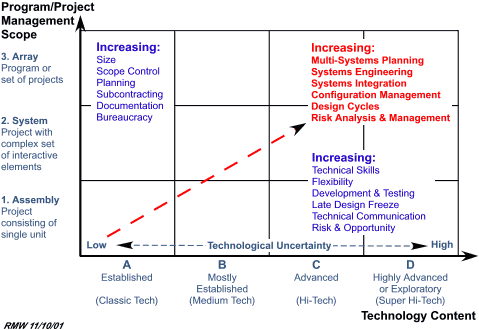Proposed Project Classification System
Understanding the descriptors along each dimension of Figure
3 is important. The three levels of complexity are as follows.
Level 1 - Assembly: This represents a project consisting of a
collection of components and modules combined into a single unit. A typical assembly
may perform a well defined function within a larger system, thus constituting
one of its subsystems, or it can be an independent self-contained product that
performs a single function of a limited scale. A computer's central processing
unit, its display screen, or its printer are three separate examples of the former,
while radios, washing machines or a single family home are examples of the latter.
Level 2 - System: This represents a project consisting of a complex
collection of interactive elements and subsystems within a single product, jointly
performing a wide range of independent functions to meet a specific operational
mission or need. Examples include radar, computer work stations, any form of
transportation vehicle, or multiple-use high-rise buildings.
Level 3 - Array: This represents a program, rather than a single
project, where program is taken to mean a series of related projects designed
to accomplish broad goals and to which the individual projects contribute. Often,
arrays are dispersed over wide geographical areas, or over an extended period
of time, and consist of a variety of project systems. Examples include any of
a city's infrastructure, inter-airport airside control, or any of the national
defense systems.

Figure 3: Proposed Project Typology
The four levels of Technological Uncertainty depend on the technology content
of the project. They are as follows.
Type A - Established Technology: These projects rely on existing
and well established base technologies to which all industry players have equal
access. Although such projects may well be very large in scale, no new technology
is employed at any stage. The majority of projects in the construction and road
building industries fall into this category.
Type B - Mostly Established Technology: These are similar to
Type A, but involve some new technology or feature. While the majority of the
work has relatively low uncertainty, the new feature provides market advantage
but also a higher degree of uncertainty. Examples include many industrial projects
of incremental innovation, as well as improvements and modifications to existing
products.
Type C - Advanced Technology: Often referred to as High-Tech
projects, these are projects in which most of the technologies are employed together
for the first time. However, the individual technologies already exist, having
been developed prior to project initiation. Defense industry projects typically
fall into this category.
Type D - Highly Advanced Technology: Such projects require exploratory
development and may be referred to as Super High-Tech. They call for the incorporation
of technologies which are not entirely existing, emerging or even unknown solutions
at the time of project initiation. Project execution therefore involves technology
development, testing and selection from among alternatives. Research and development
projects fall into this category.
|



